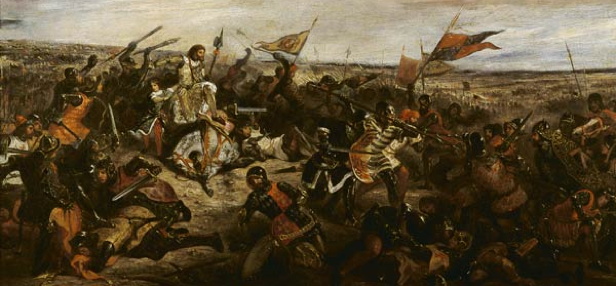Devastating Lance
 The lance was deadly to disorganised infantry and missile troops. The ability to hold the lance in a horizontal position and keep control of a speeding horse required skill and stamina but it’s effects in a mass cavalry charge could destroy armies.
The lance was deadly to disorganised infantry and missile troops. The ability to hold the lance in a horizontal position and keep control of a speeding horse required skill and stamina but it’s effects in a mass cavalry charge could destroy armies.
Armour piercing Crossbow
The crossbow was so effective against armoured warriors that a papal bull banned it’s use during the medieval period – few armies observed the ban. In fact the crossbow was one of the most popular weapons used in medieval armies, while it was cumbersome to load, the impact of it’s bolts could take a man’s head off.
Brutal Mace and Morning Star
The mace was used in close combat, the soldier would use the spiked clubs to batter through armour, skin and bone causing horrific injuries to enemy infantry.
As the illustration shows they came in many shapes and sizes some were designed to offer more damage on direct impact others could be mounted on chains, swung around and hammered down onto the hapless victim.
Long range Longbow
The English longbow offered superior range and good stopping power especially against mounted troops. The English adopted the longbow after engagements with the welsh, it worked best when it was made from yew trees which gave it the strength it needed to outrange smaller bows. When used by well trained troops, 10 arrows could be fired a minute at a distance of 200 metres to create a spiked storm of death.
Fearsome Claymore
 The fearsome Scottish Claymore, or great sword, was designed to be wielded using two hands, was too large to be carried on the waist and so it had to be swung over the shoulders as the illustration shows. During charges it was wielded above the head with it’s huge blade coming crashing down on enemy infantry. It was not uncommon for victims to literally be carved in half if there was enough force behind the strike.
The fearsome Scottish Claymore, or great sword, was designed to be wielded using two hands, was too large to be carried on the waist and so it had to be swung over the shoulders as the illustration shows. During charges it was wielded above the head with it’s huge blade coming crashing down on enemy infantry. It was not uncommon for victims to literally be carved in half if there was enough force behind the strike.



